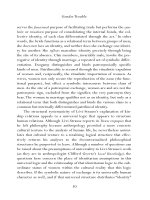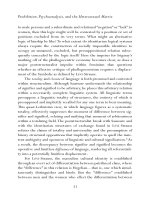GENDER TROUBLE 14
Bạn đang xem bản rút gọn của tài liệu. Xem và tải ngay bản đầy đủ của tài liệu tại đây (18.21 KB, 1 trang )
Preface 1999
discrimination to MacKinnon’s, effectively arguing that sexual harassment is the paradigmatic allegory for the production of gender. Not all
discrimination can be understood as harassment.The act of harassment
may be one in which a person is “made” into a certain gender. But there
are others ways of enforcing gender as well. Thus, for Franke, it is
important to make a provisional distinction between gender and sexual discrimination. Gay people, for instance, may be discriminated
against in positions of employment because they fail to “appear” in
accordance with accepted gendered norms. And the sexual harassment
of gay people may well take place not in the service of shoring up gender hierarchy, but in promoting gender normativity.
Whereas MacKinnon offers a powerful critique of sexual harassment, she institutes a regulation of another kind: to have a gender
means to have entered already into a heterosexual relationship of subordination. At an analytic level, she makes an equation that resonates with
some dominant forms of homophobic argument. One such view prescribes and condones the sexual ordering of gender, maintaining that
men who are men will be straight, women who are women will be
straight.There is another set of views, Franke’s included, which offers a
critique precisely of this form of gender regulation.There is thus a difference between sexist and feminist views on the relation between gender and sexuality: the sexist claims that a woman only exhibits her
womanness in the act of heterosexual coitus in which her subordination
becomes her pleasure (an essence emanates and is confirmed in the sexualized subordination of women); a feminist view argues that gender
should be overthrown, eliminated, or rendered fatally ambiguous precisely because it is always a sign of subordination for women.The latter
accepts the power of the former’s orthodox description, accepts that
the former’s description already operates as powerful ideology, but
seeks to oppose it.
I belabor this point because some queer theorists have drawn
an analytic distinction between gender and sexuality, refusing a causal
or structural link between them. This makes good sense from one
xiii









